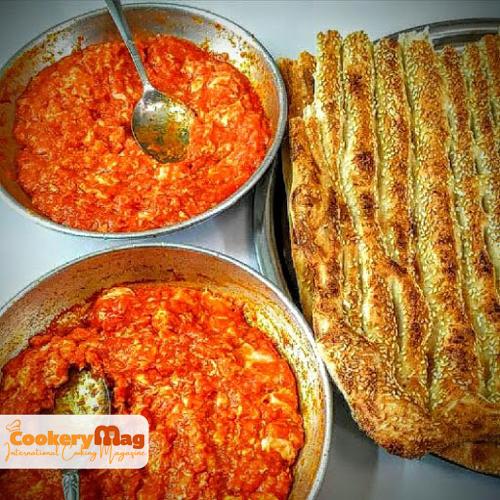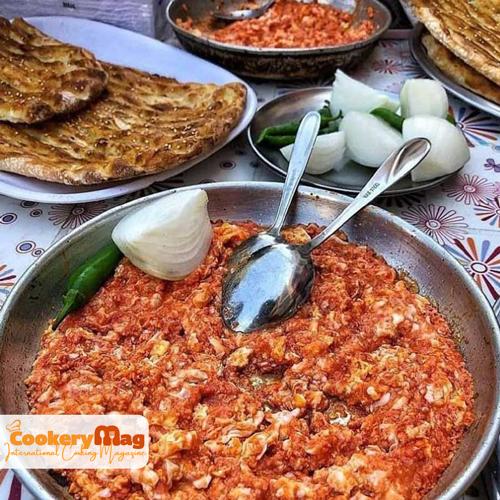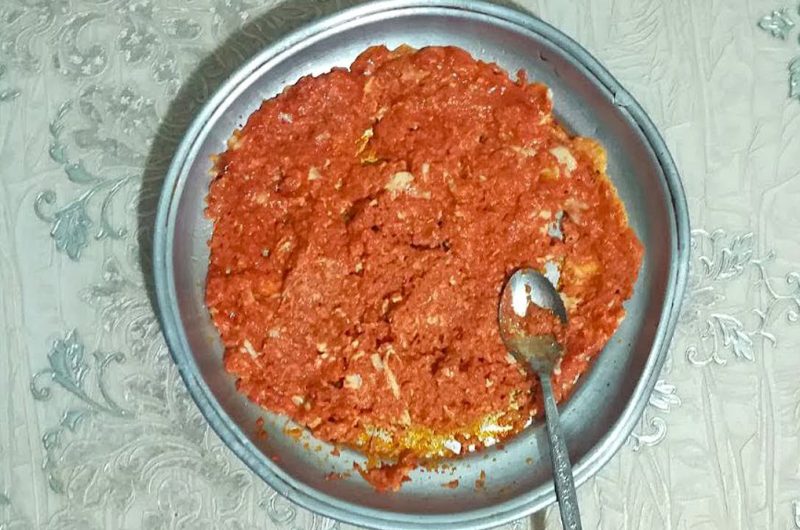© All Rights Reserved.
Persian Omelette Recipe | Delicious Tomato Omelette in 6 steps
Persian Omelette (in French: Omelette) is an instant food whose main ingredient is eggs.
In making an omelette, you have to mix the scrambled egg with any other desired ingredient and sometimes fold it. Still, in Iran, only the mixture of egg and tomato or tomato paste is called omelette, which is prepared in a pan, along with oil or butter and paste.
When the oil is hot with the paste, they add the mixture of eggs to it, and sometimes, they mix the egg after adding it to the paste.
In the original recipe, the prepared omelette is folded, and vegetables, cheese, cooked meat (often ham or bacon), or a combination of them are placed inside.
In order to make the omelet light and fluffy, milk, cream, or even water is sometimes added to the egg whites that have been beaten separately (or all the eggs have been beaten).
To have an amazing recipe of how to make a Persian Omelette, be with Cookery Magazine.
Ingredients for making Persian Omelette
| Tomatoes | 8 large pcs |
| Onion | 1 large piece |
| Egg | 4 pcs |
| Garlic | 1-3 cloves |
| Bell pepper (optional) | 1 large piece |
| Salt and black pepper | As much as needed |
| Oil and thyme | As much as needed |
Recipe for making Persian Omelette
The first step
If you don’t like to make the Persian Omelette without onions, we recommend that you make it with onions only once to notice the difference in taste.
First, we cut the onion into small pieces and fry it in a suitable pan with some oil.
The second step
After the onion becomes light, then we grate the garlic in the pan and fry it a little; Then, we add some spices (curry spice, turmeric, etc.) to the onion, and after frying a little, we take the skin of the tomatoes and chop them into small pieces, then add them to the pan containing the onion.
The third step
We fry the tomatoes a little, then put the lid of the pan so that the tomatoes drain. If you fry the tomatoes with high heat, you don’t need to cover the pan because the extra water evaporates very quickly.
The fourth step
If you want to use bell pepper in your omelette, chop it finely and add it to the pan. At this stage, we should fry the tomatoes and bell peppers until they are completely soft and cooked and add oil.
The fifth step
Now, it’s time to add the eggs. We can break the eggs in a bowl and mix them, then add them to the pan all at once or break them one by one and add them to the pan. Add the eggs along with thyme.
The sixth step

Next, add some salt and black pepper and stir the ingredients continuously until the eggs harden and cook completely. After the omelette is ready, we serve it with Barbari bread or fresh Sangak bread.
Proper bread for Persian Omelette
The first thing about the bread you want to serve with the Persian omelette is that it is fresh and hot, if possible.
Another point is that it is better to serve the omelette with Barbari bread. With the following tutorial, you can make traditional Barbari bread at home.
Golden tips for having the best Tomato Omelette
The recipe for a Persian Omelette may seem simple and easy. But if you plan to make a delicious omelette, you should pay attention to some points:
- Be sure to break all the eggs in a bowl and season with salt and pepper before adding them to the pan. Then, mix the eggs with a fork and then add them to the pan.
- If you use tomatoes in omelette, be sure to peel them. In addition, instead of grating, it is better to cut the tomatoes into cubes and roast them; This will make the Tomato Omelette more delicious.
- It is better to use more oil; Because the omelette is delicious and fatty! For this, use a combination of olive oil and butter.
- Always use turmeric in making omelette. Roast turmeric with vegetables or tomatoes, and then add beaten eggs. Turmeric has an amazing effect on removing the bad smell of eggs.
- The last thing is that after adding the eggs to the pan, be sure to lower the heat so that the eggs cook slowly. Avoid putting the lid on the pan at this stage.
By following these simple tips, you will have a delicious and different omelet.
Having a journey in the history of Tomato Omelette
The word omelet itself is a French word, but many French people may not have heard of it until Napoleon Bonaparte understood this dish.
There is an old legend that says that many years ago when Napoleon passed through the south of France, he decided to stay for a night near the town of Bessières.

The people of the city welcomed him in a local guest house, and his host prepared an omelet for him, which Napoleon was delighted with.
He immediately ordered the collection of all the eggs in the city and the cooking of a huge omelet for his entire army.
Years later, the people of that town in the south of France cook and celebrate once a year in a huge omelette festival.
Alan Davidson, a famous British nutritionist, believes that omelette is an updated food of traditional and old food of the people of the planet.
Some documents show that the origin of the omelette goes back to ancient Iran.
Different nations, such as the Romans and the Chinese, made food using eggs and other food items such as dairy products.
However, Davidson believes that the origin of the French word omelette dates back to the middle of the 16th century.
Some researchers believe that the omelette is a version of an ancient modified dish that was popularized again in France in the 16th century.
The method of cooking an omelette is the same in many sources and countries, but it has different raw materials; usually, milk is not considered a part of the main recipe, but in England, milk and a type of cheese are among the main raw materials for preparing this food.
However, some historical documents show that the use of words such as alumelle and alumete, which were similar to the word omelette, goes back to books and magazines related to housekeeping in 2013 AD.
Alan Davidson states that the use of the word omelet in the modern sense (omelet meaning a type of food) dates back to a publication called “Traditional Bourgeois Cookery” in 1784.
Since then, the word “omelette” has been used in the modern sense and has gradually been transferred to other parts of the world.
After that, each of the nations and countries of the world invented a type of omelet according to their taste.
Persian Omelette (Tomato Omelette) was introduced in different cities of Iran through famous tea houses (traditional Iranian coffee houses).
The Iranian type of omelet called Khagineh is also prepared and cooked in some regions of the country, and sugar is also added to it.
The recipe for Omelette is slightly different in different countries; for example, the Mexican omelet is slightly different from the Persian Omelette.
Now, here, Iranians mean the word omelette, tomato omelette.
Tomato omelette is a ready-made breakfast meal that is mainly popular in the Maharashtra region. This dish is called an omelet because of its appearance, but it does not actually contain eggs.
Its main ingredient is chickpea flour. Sometimes tomato omelette is prepared with rice flour and soy paste, and beans are also used in it.
In this case, if you pour the ingredients on the dough and cook, you will have a special Indian breakfast, which is called Uttapam in India, as well as coffee shop omelette or tomato omelette, which are other authentic omelettes of our country.
Meanwhile, tomato omelette is the most popular Persian omelette.
Omelet is a very popular food and has different types such as vegetables, mushrooms, cheese, tomatoes, ham, etc.

The dough is prepared from water and ordinary flour, and hot green pepper, chopped onion, and tomato are added to it.
The mixture is fried on both sides in a pot with cooking oil. Tomato omelette is served hot with tomato sauce and coconut pickle or sambar or any other pickle.
This dish is found in all the restaurants and delis across Maharashtra in the cities of Pune and Mumbai and is very popular.
It is also a popular dish in canteens of regional universities such as VJTI and Pune University.
Although this delicious breakfast is available in restaurants all over the country, it is generally prepared in the homes of the people of Maharashtra with the same recipe and various ingredients in the dough, and it is prepared and eaten under different names such as Thali Pis and Zirdeh.
Conclusion
Thank you for being with us with this delicious and popular food. If you have any questions, it’s my honor to answer. Enjoy your exploration of Persian cuisine!
Bursting with the unique taste of Persian tomatoes and an array of fresh herbs, this dish offers a culinary journey into the heart of Iran.
Please share this article with your friends on Facebook, Twitter, Pinterest, and other social media. 🧡
Persian Omelette Recipe | Tomato Omelette
Course: Main FoodCuisine: Persian FoodDifficulty: Easy2
servings20
minutes20
minutes300
kcalPersian cuisine is a treasure trove of flavors, and one dish that exemplifies this richness is the Persian Tomato Omelette.
Ingredients
Tomatoes, 8 large pcs
Onion, 1 large piece
Egg, 4 pcs
Garlic, 1-3 cloves
Bell pepper (optional), 1 large piece
Salt and black pepper, As much as needed
Oil and thyme, As much as needed
Directions
- The first step
If you don’t like to make the Persian Omelette without onions, we recommend that you make it with onions only once to notice the difference in taste.
First, we cut the onion into small pieces and fry it in a suitable pan with some oil. - The second step
After the onion becomes light, then we grate the garlic in the pan and fry it a little; Then, we add some spices (curry spice, turmeric, etc.) to the onion, and after frying a little, we take the skin of the tomatoes and chop them into small pieces, then add them to the pan containing the onion. - The third step
We fry the tomatoes a little, then put the lid of the pan so that the tomatoes drain. If you fry the tomatoes with high heat, you don’t need to cover the pan because the extra water evaporates very quickly. - The fourth step
If you want to use bell pepper in your omelette, chop it finely and add it to the pan. At this stage, we should fry the tomatoes and bell peppers until they are completely soft and cooked and add oil. - The fifth step
Now, it’s time to add the eggs. We can break the eggs in a bowl and mix them, then add them to the pan all at once or break them one by one and add them to the pan. Add the eggs along with thyme. - The sixth step
Next, add some salt and black pepper and stir the ingredients continuously until the eggs harden and cook completely. After the omelette is ready, we serve it with Barbari bread or fresh Sangak bread.
Notes
- Be sure to break all the eggs in a bowl and season with salt and pepper before adding them to the pan. Then, mix the eggs with a fork and then add them to the pan.
- If you use tomatoes in omelette, be sure to peel them. In addition, instead of grating, it is better to cut the tomatoes into cubes and roast them; This will make the Tomato Omelette more delicious.
- It is better to use more oil; Because the omelette is delicious, fatty! For this, use a combination of olive oil and butter.
- Always use turmeric in making omelette. Roast turmeric with vegetables or tomatoes, and then add beaten eggs. Turmeric has an amazing effect on removing the bad smell of eggs.
- The last thing is that after adding the eggs to the pan, be sure to lower the heat so that the eggs cook slowly. Avoid putting the lid on the pan at this stage.
Frequently Asked Questions about Persian Omelette
What is the reason why Tomato Omelette stick to the bottom of the pan?
The most important reason for coffee house omelet sticking to the bottom of the pan is the low amount of omelet oil.
If you use more oil in this omelette, your omelette will be tastier. Remember that the gas flame should not be too high while cooking the omelette.
In which pan should we make a coffee house omelette?
The best frying pan for making omelette and tomato omelette in the coffeehouse-style is the zinc or spirit frying pan. It is better not to use a cast iron or Teflon pan.


